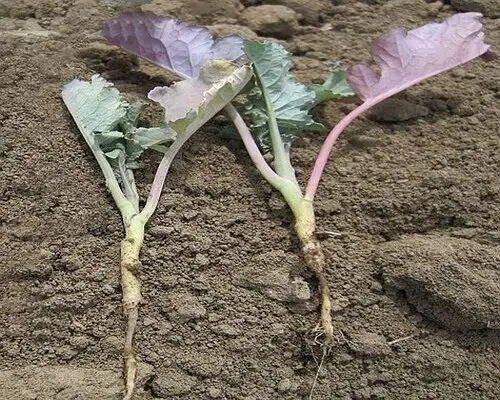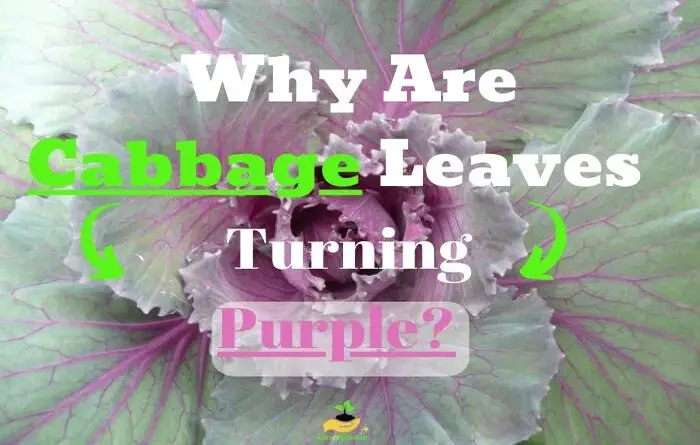5 Reasons Cabbage Leaves Are Turning Purple (How To Fix It)
Sometimes even experience gardeners encounter such a phenomenon as the appearance of purple leaves on cabbage. It is not always necessary to panic but is necessary to understand why cabbage leaves are turning purple and depending on the cause to take appropriate measures.
There are several reasons cabbage leaves turn purple as: lack of phosphorus, low temperature of seedlings or damage by a fungus called black leg. You can fight with home remedies or with the help of fungicides. So, if the leaves of the seedlings turn purple shortly after planting it in the garden, this is most likely a environmental stress and everything will pass with time. But if the purple color happened later, the cause may be more prefund.
| Causes of Cabbage Leaves Turning Purple: |
|---|
| 1. Nutrients Deficiency |
| 2. Environmental Stress |
| 3. Low Temperatures |
| 4. Diseases and Pests |
| 5. Natural Varieties |
1. Nutrients Deficiency
Cabbage, like any crop, needs certain trace elements for full development. And when there is a shortage of them, the plant reacts to this by slowing down in growth and changing its appearance.
At the beginning of its development, cabbage requires few nutrients. As it grows, it consumes more and more trace elements, and if there are not enough of them in the soil, then the plant can not only change the color of the leaves, but also curl and die.
Reddish-purple coloration along the veins on the underside (reverse) side of the leaf is a clear symptom of phosphorus starvation.
Phosphorus deficiency
In most cases, cabbage leaves turn purple due to a lack of phosphorus. At the first stages, only the veins become purple, then, all the central parts of the leaves become purple, while the edges turn yellow and die.
With a lack of phosphorus, the veins of the leaves first become purple, and then the color changes throughout the leaf, moving inside the head of the cabbage.
When introducing phosphorus, the acidity of the soil must also be taken into account: phosphorus due to increased or decreased acidity of the soil is absorbed worse.
If you initially forgot to add phosphorus fertilizers for digging or applied too little, in this case, you need to urgently perform phosphorus top dressing.
It is worth noting that cabbage requires little phosphorus for normal development, but its lack can destroy the culture, so the introduction of this mineral should occur on time.
It is believed that the introduction of 3-5 kg of manure per square meter of soil every four years provides cabbage with phosphorus (with annual cultivation of crops on this soil bed) by 100%.
Treatment
It is important to maintain a balance of nitrogen, phosphorus, potassium and magnesium. Only in this case, the cabbage leaves will have the usual green color.
For treatment, you can use superphosphate or homemade organic fertilizer based on manure, litter or other organic matter as follows:
| Type of phosphorus fertilizers | Quantity | How to apply |
|---|---|---|
| 1. Monopotassium phosphate | 5 g/5 liters of water (contains 50% phosphorus and 33% potassium) | For 1 sq. m. of soil, 5 liters of such a solution should be spent. |
| 2. Superphosphate | 100g/10 liters of water | Water 0.5 liters of solution per cabbage bush. It takes about 500-700 ml of liquid solution per cabbage bush. |
| 3. Double superphosphate | 50 g/10 liters of water | Water 0.5 liters of solution per cabbage bush. |
| 4. Wood ash | 1 tbsp/10 liters of water | Water 0.5 liters of solution under each cabbage root twice with an interval of 3 weeks. |
| 5. Bone meal | 1 tbsp/1 liter of water | One liter of this mixture is required for 1 sq. m. of soil, watering cabbages under the root. |
| 6. Manure | A ratio of 1:10 (1 part of manure and 10 parts of water) | 3-5 kg of manure is applied per 1 sq. m. of soil. |
2. Environmental Stress
Cabbage leaves are turning purple due to the following environmental stress factors:
- Waterlogging. When the soil is noticeably waterlogged, this negatively affects the root system;
- Hypothermia. Night frosts inhibit the development of vegetables which occurs as a result of the lack of a hardening procedure
- Soil quality(pH). Before planting, the land was not cultivated.
They become purple gradually, and often only half of the head of the cabbage acquires this shade. But if young heads of cabbage turn purple, then there is nothing to worry about. After 2-3 weeks of quality care, the cruciferous vegetable will recover and become green again.
Transplanting

Quite often, cabbage leaves are turning purple due to transplanting stress (after transplanting cabbage seedlings to a permanent place).
This usually happens when planting seedlings in open ground. The cabbage finds itself in unusual conditions (due to fluctuations in temperature and changing growing conditions) and begins to experience stress, which, can also be seen as a purple tint in the leaves.
Most often, purple leaves can be observed in non-hardened cabbage seedlings .
There is nothing to worry about, such cabbage seedlings usually recover on their own in 2-3 weeks and the leaves will turn green again.
Incorrect soil pH
It often happens that there is a sufficient amount of phosphorus in the soil, but it is inaccessible (hard to reach) to the plant, because it was blocked (bound) by another chemical element due to increased or decreased acidity of the soil.
However, if there is enough phosphorus in your soil, but it is blocked, then you can use microbiological fertilizers, which contain bacteria that convert insoluble phosphorus compounds (as well as potassium) into a form available that can be absorbed by the cabbage.
This vegetable crop does not grow well in acidic soils. Suitable loamy, sandy and clay types of soil. If it is not possible to replace the acidic soil, it must be limed before planting a vegetable crop.
Treatment
Acidic soil is not suitable for growing cabbage. This feature must be taken into account and cultivated on neutral or slightly alkaline loose soils . It is better to give preference to sandy and clay soils.
If the pH of the soil is below 6.5, it is necessary either to completely abandon the planting of cabbage, or to deoxidize it as a rule. For this, the soil is mixed with dolomite powder
Dolomite powder is rich in calcium and magnesium – those elements that are necessary for the full development of the cabbage. The recommended dosage of the deoxidizer is 200-300 g per 1 sq. m.. Treatment should be carried out, once every 5-6 years.
Waterlogging
The primary factor of environmental stress is improper watering. Excessive waterlogging and drying of the soil should not be allowed. The ground under the cabbage heads should always be loose and slightly moist.
Waterlogging of the soil, which often occurs in rainy summers, also has a bad effect on cabbage in the form of purple leaves. Long rains during the summer growth period can contribute to stress.
On such days, you do not need to water, you should increase the loosening of the soil. You can make narrow grooves to drain excess water.
Before starting to plant, in case of insufficiently moist soil, it is advisable to spray the area with water at the rate of 3-4 buckets per 1 sq. m..
After partial drying of the soil bed, you can begin to dig holes, into each of which, immediately upon planting, pour 1 liter of settled water.
Treatment
| Environmental cause | Method of treatment |
|---|---|
| Freezing when growing conditions change | The crop should be insulated. This will help to cover the cabbage seedlings with special materials. Seedlings or beds with crops are covered with agricultural spunbond (horticultural fleece). The material will allow the vegetable crop to withstand frosts down to 14°F ( -10°C). Perfectly protects plantings from wind, hail and snow. Another way is mulching: rotted grass, straw, branches of fruit trees, mulch-paper and other materials are used. |
| Soil dryness | Carry out abundant watering. For 1 cabbage head, use 2-3 liters of water. |
| Waterlogging of the soil | This is a common occurrence during periods of heavy rains. It is better to stop additional watering altogether. After the rain stops, special conditions must be created for the evaporation of excess moisture. To do this, destroy the soil crust and loosen the soil. If there is too much water, grooves are made. They are placed between rows to drain excess water. |
3. Low Temperatures
Most often this happens in spring or late autumn before harvest. A sharp drop in temperature (hypothermia) comes, and the leaves of the cabbage acquire a purple hue.
Often cabbage turns purple when planting its seedlings in open ground. If the gardener did not initially harden the cabbage bushes, then when planted in open ground, the leaves will turn purple due to normal hypothermia.
Therefore, no less common cause is cold weather, in other words, too low temperature of the soil and environment, due to which the root system of the cabbage crop is simply not able to absorb the phosphorus in the soil.
Make a liquid top dressing with a warm solution of one of the phosphorus fertilizers. Moreover, you can try to carry out foliar spraying directly on the leaves, only some kind of adhesive (the same soap) must be added to the solution.
Through the leaves, cabbage can absorb phosphorus even at relatively low temperatures.
Moreover, in the future, this significantly undermines the immunity of the culture: cabbage becomes susceptible to most diseases and pests, and grows inactively.
Before planting cabbage seedlings outside, the box with the seedlings is hardened: they leave it for several hours in the open air, gradually increasing the time daily.
Treatment
Return frosts can also adversely affect young plants. Seedlings are insulated, preventing sub-zero temperatures, with the help of a special covering material (agricultural spunbond). This method will allow the crop to endure frosts on the soil surface and protect against heavy rainfall.
It is clear that you will hardly succeed in raising the temperature, however, you can try to make a greenhouse on arcs, in other words, a warm shelter for cabbage.
There is no need to be afraid of this either, with the onset of heat, the color of the cabbage leaves will take on a natural color.
4. Diseases
Cabbage Black Leg
The most dangerous reason why cabbage leaves turn purple is a disease called blackleg. This is a dangerous fungal disease that first affects the root system and only then, in advanced cases, the ground part, including the leaves, begins to suffer.
Damage to the root system by fungal diseases is also often reflected in the color of the foliage. Usually affects Beijing and white cabbage varieties.
Unfortunately, when the cabbage leaves begin to turn purple, the disease is already at such a stage that it is easier to remove the affected plant so as not to endanger neighboring ones than to try to treat it.
Treatment
Naturally, if the cabbage is infected with this fungus, then it will not be possible to save it. There is only one way out, to destroy the crop, but to save the rest of the seedlings, you need to treat the soil bed with sulfur garden (colloidal sulfur), diluting about 10 grams of the substance in a bucket of water.
If the black leg disease did not greatly affect the plant (small dark or black spots appeared), then a special solution will help. It is made using 1% potassium permanganate, that is, potassium permanganate. Take 1 g of potassium permanganate and diluted it in 100-150 ml of water.
Manganese solution must be infused for 5-7 hours. It must be applied under the root of the head. If the vegetable crop is very severely affected, then the entire head of cabbage can be sprinkled by drip irrigation.
Pests
Purple leaves appear on cabbage leaves when attacked by pests, such as cabbage flies.
The crop may even die if measures are not taken in time and the insect and its larvae are not exterminated from the site. This can be done with the help of insecticides.
Any insecticides can help here when used strictly according to the instructions.
Treatment
To scare away the cabbage fly, dusting with a mixture of black pepper with mustard (1:1) or wood ash with ground tobacco (1:1) is used.
Plantings of marigolds, wormwood, parsley and other fragrant plants are suitable for this purpose. If the larvae have already invaded the cabbage root, then insecticide treatments are carried out.
5. Natural Varieties
Like white cabbage, red or purple cabbage is a head cabbage variety. Is a highly prized, slightly sweet-tasting edible cabbage characterized by the attractive purple, magenta or dark purple color of its leaves. Its leaves are strong, waxy and closed into a solid head.
Specifically, purple cabbage is a variety of Brassica oleracea similar to cabbage, even in flavor. However, unlike this, it has a red-violet color due to the presence of anthocyanins, water-soluble substances.
Red cabbage, it belongs to the Brassicaceae genus, which also includes broccoli, brussels sprouts, cauliflower, savory cabbage, and collard greens.
It gets its name or various names from the color of its leaves: depending on the pH of the soil, the cabbage tends to be red, blue or purple. The more acidic the soil, the redder the red cabbage becomes due to its anthocyanins (water-soluble plant pigments).
Red cabbage is also a popular winter vegetable, but it is available all year round.
In terms of taste, it differs greatly from other types of cabbage, compared to white cabbage, it tastes rather sweet.
It is a plant that spikes easily in the cold, so the use of tunnels is recommended in early spring plantings.
How to Prevent Cabbage Leaves from Turning Purple
To prevent cabbage leaves from turning purple, you should take the following steps:
- Choose a disease resistant cabbage variety. It is preferable to grow those varieties that are resistant to diseases and low temperatures.
- Inspect cabbage leaves at least once a week. This will allow timely detection of symptoms of the disease and prevent the appearance of purple leaves.
- Have a regular watering schedule (2-3 times a week depending on the soil moisture)
- Apply fertilizer not only based on phosphorus, but also with an organic or mineral composition.
- Make sure to protect cabbage from cold temperatures by covering the soil with horticultural fleece.
- Carry out hardening of young cabbage seedlings before transplanting outside.
- Check soil pH before planting and make sure it is not acidic.
Conclusion
When cabbage leaves are turning purple, knowing the cause of its occurrence and taking timely measures to eliminate them will help the further growth and development of the crop.
Well, now you know why cabbage leaves change color, what are the causes of this problem (lack of nutrition, namely phosphorus), and what can and should be done in this situation. Good luck!
Frequently Asked Questions
When you notice a plant with purple leaves rather than the normal green color, it is most likely due to a phosphorus deficiency. All plants need phosphorus (P) to create energy, sugars and nucleic acids.
Plants have such a component as anthocyanin which it is responsible for the shades of purple-blue in the color of plants. When there is a lack of phosphorus, this element becomes many times larger, and therefore a purple hue appears. The plant begins to weaken, since phosphorus is especially needed during the growing season.
The answers to these questions are all linked to the presence of a special substance: chlorophyll, a green pigment found inside most of the cells that form a leaf or the young stems of plants.
Phosphorus deficiency tends to inhibit stem growth. Leaves turn dark, dull, blue-green in color and may turn pale in severe deficiencies. The reddish, or red-violet color is sometimes developed by the synthesis of anthocyanins.




